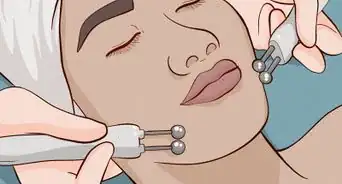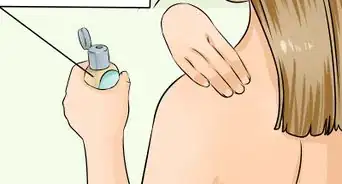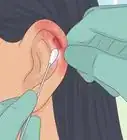This article was medically reviewed by Mark Ziats, MD, PhD. Dr. Mark Ziats is an Internal Medicine Physician, Scientist, Entrepreneur, and the Medical Director of xBiotech. With over five years of experience, he specializes in biotechnology, genomics, and medical devices. He earned a Doctor of Medicine degree from Baylor College of Medicine, a Ph.D. in Genetics from the University of Cambridge, and a BS in Biochemistry and Chemistry from Clemson University. He also completed the INNoVATE Program in Biotechnology Entrepreneurship at The Johns Hopkins University - Carey Business School. Dr. Ziats is board certified by the American Board of Internal Medicine.
There are 8 references cited in this article, which can be found at the bottom of the page.
This article has been viewed 15,939 times.
Have you damaged your skin with tanning or sunburns? Unfortunately, damage from sunlight and ultraviolet (UV) rays is more or less permanent and can never be fully healed, leading to blemishes, wrinkles, or possibly even skin cancer over time; however, you can still take steps to heal burns and repair some long-term damage. Most importantly, you can also limit your future UV exposure.
Steps
Treating Skin for Sunburn
-
1Apply a moisturizer. Use moisturizer liberally on the sunburned area of skin to cool, soothe, and start to restore your damaged skin. Moisturizer won’t heal a sunburn, but it will calm irritation and make you feel better.
- Try a moisturizer with aloe vera, which has natural soothing properties. A cream or gel with hydrocortisone can also help, as it reduces swelling and inflammation and relieves pain.
- Reapply the moisturizer or other cream often, several times per day.
- Drink plenty of water as well. Sun exposure causes fluid loss through the skin, so replenish your body’s fluids.
-
2Relieve pain and itching. Sunburns are uncomfortable — stinging, itchy, or both. Try to find other ways besides skin creams to relieve this discomfort. Compresses, baths or showers, and pain medication can all work.[1] [2]
- Take cool showers or baths to cool your skin. You can also apply a cool compress to the area, like a damp washcloth or towel. Avoid alcohol and products containing alcohol, however, which can dry out the skin.
- Consider over-the-counter pain medication like ibuprofen to control pain, as well, until the soreness and swelling subside. Ibuprofen in particular will reduce the inflammation in the skin that is causing the pain. Tylenol may also be appropriate, but it will likely not be as effective.
- For itching, dab some calamine lotion on the affected area and repeat as needed. If you are allergic to lidocaine, avoid any topical pain relievers with “-caine” in the name (like benzocaine), as they may cause allergic reactions.
Advertisement -
3Treat blistered and peeling skin gently. Your skin may blister and then peel away after a sunburn, depending on the severity of the burn. Don’t be tempted to intervene in this process — it’s our body’s natural way of dealing with damaged skin. In fact, picking and peeling skin can slow the healing process rather than help it.
- Don’t pick or pop blisters. Blisters are a protective barrier that your body forms, and popping them can cause infections and slow your healing.
- Instead, cover any blisters with gauze — you can wet the gauze with water first to make it more comfortable on the blister. If they break, wash them with soap and warm water, apply a disinfectant cream, and cover them with a wet bandage.
- Your outer, damaged skin may peel away as you heal. Let it be. Do continue to apply moisturizer frequently, though.
Repairing Long-Term Damage
-
1Use a retinoid cream. Retinoid creams are made from vitamin A and usually applied topically to the skin, like Retin-A, Tazorac, Renova, and others. When used in this way, they help you to shed old skin cells and partly restore damaged collagen. Look for them in local pharmacies or ask your dermatologist to recommend one.[3] [4]
- Be aware that retinoids can make your skin itchy, dry, or scaly. Use them together with a good moisturizer.
- Topical retinoids can also make your skin more vulnerable to burning, so be sure to combine them with a strong sunscreen (at least SPF 30) and also protective clothing when outdoors.
-
2Get laser treatment for long-term damage. Laser treatments will “resurface” your skin to remove outer, damaged layers and allow the underlying layers to grow in their place and heal. It can remove mottled patches and wrinkles caused by sun damage and also stimulate new collagen growth, improving the appearance of leathery skin.[5] [6]
- Talk to a board-certified dermatologist about your options. She may recommend “ablative” laser treatment, which is more aggressive and will take a few months to heal — but, the effect can be more pronounced.
- There is a second type of “non-ablative” laser treatment. This procedure carries less risk and offers a more subtle effect. You may also have to repeat the process several times to see results.
-
3Try a chemical peel or dermabrasion. Chemical peels and dermabrasion are two other ways to renew your skin and to lessen the effects of long-term sun damage. Both involve removing the top layers of your skin and stimulating underlying layers to grow, ideally leading to new, tighter, and younger-looking skin. Talk to a dermatologist about these procedures to see which might work for you.[7]
- In a chemical peel, a doctor will remove the top layers of your sun-damaged skin with a weak acid. The idea, as in laser treatment, is to encourage the growth of new and younger looking skin cells for smoother skin.
- Dermabrasion works the same way, but uses an abrasive brush rather than acid. You can get deep dermabrasion or lighter microdermabrasion, which only removes the top-most layer of skin.
- Be aware that both of these procedures can cause discomfort, redness, or swelling and may take some time to heal. They are often expensive and generally not covered by insurance because they are considered cosmetic-only procedures, not medically necessary procedures.
Limiting Your UV Exposure
-
1Use sunscreen when outdoors. To prevent more damage to your skin, take basic precautions whenever you go outside. These practices won’t restore your skin to its original condition, but they will keep you from making the situation worse. Your first basic line of defense should be a strong sunscreen.[8]
- Apply sunscreen liberally whenever you go outside. You should put it on whether or not it is sunny, on all exposed skin.
- Use SPF 30 or higher. Give the sunscreen at least 30 minutes to absorb into your skin and reapply it every two hours or after going swimming or sweating heavily.
-
2Wear protective clothing. Try to limit your other exposure to direct sunlight, as well. The less total sunlight your skin absorbs, the less damage it will have over the long-term. Use clothing, hats, umbrellas, shade, sunglasses, and other wear for the best protection.[9]
- Favor loose-fitting garments made from tightly woven fabric, as these offer better protection. Dark colors and dry garments also protect better than light colors and wet clothing.
- Don a hat — ideally, a wide-brimmed hat — and sunglasses. Try to get sunglasses that block 99% or more of UV and UVB rays.
- Use shade to your advantage. Also try to do your outdoor activities when the sunlight is not direct, either in the morning or in the later afternoon and evening.
-
3Give up sunbathing and tanning. One of the worst things you can do to your skin is expose it to direct UV light through sunbathing and tanning. You may have already noticed skin damage from your tanning. In the long run, overexposure to the sun can reduce your skin’s elasticity, create blemishes, and make the skin appear leathery. It also puts you at an elevated risk for skin cancer.[10] [11]
- Avoid tanning outdoors. Sunscreen will not “counteract” the harmful UV rays.
- Indoor tanning rooms and beds are just as harmful to your skin as natural sunlight. In fact, they can actually produce more concentrated UV rays.
- If you want a tan, opt for an artificial spray-on or rub-on tan. It is much safer and kinder to your skin.
References
- ↑ http://www.webmd.com/skin-problems-and-treatments/tc/sunburn-home-treatment
- ↑ http://www.skincancer.org/prevention/sunburn/treating-sunburn-in-children
- ↑ https://www.aocd.org/page/Retinoidstopical
- ↑ http://www.skincancer.org/skin-cancer-information/ask-the-experts/reverse
- ↑ http://www.skincancer.org/skin-cancer-information/ask-the-experts/reverse
- ↑ http://www.mayoclinic.org/diseases-conditions/wrinkles/basics/treatment/con-20029887
- ↑ http://www.mayoclinic.org/diseases-conditions/wrinkles/basics/treatment/con-20029887
- ↑ https://my.clevelandclinic.org/health/healthy_living/hic_An_Overview_ofYour_Skin/hic_protecting_yourself_from_sun_damage
- ↑ http://www.skincancer.org/skin-cancer-information/ask-the-experts/reverse

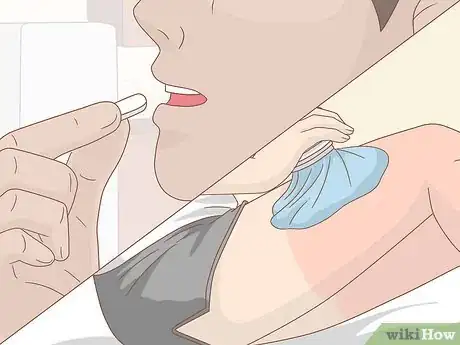



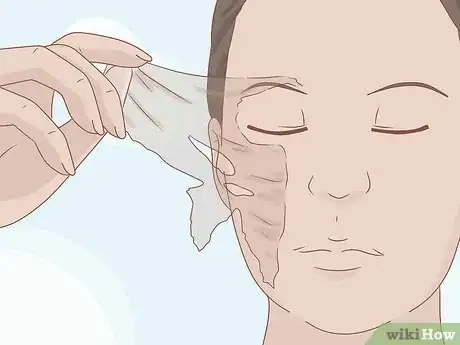



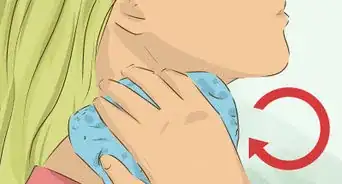
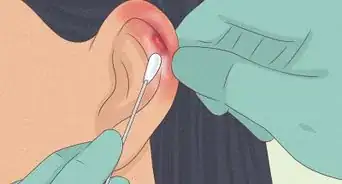
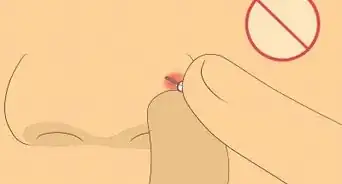


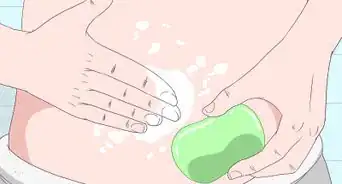
-Electric-Shock-Step-9.webp)

